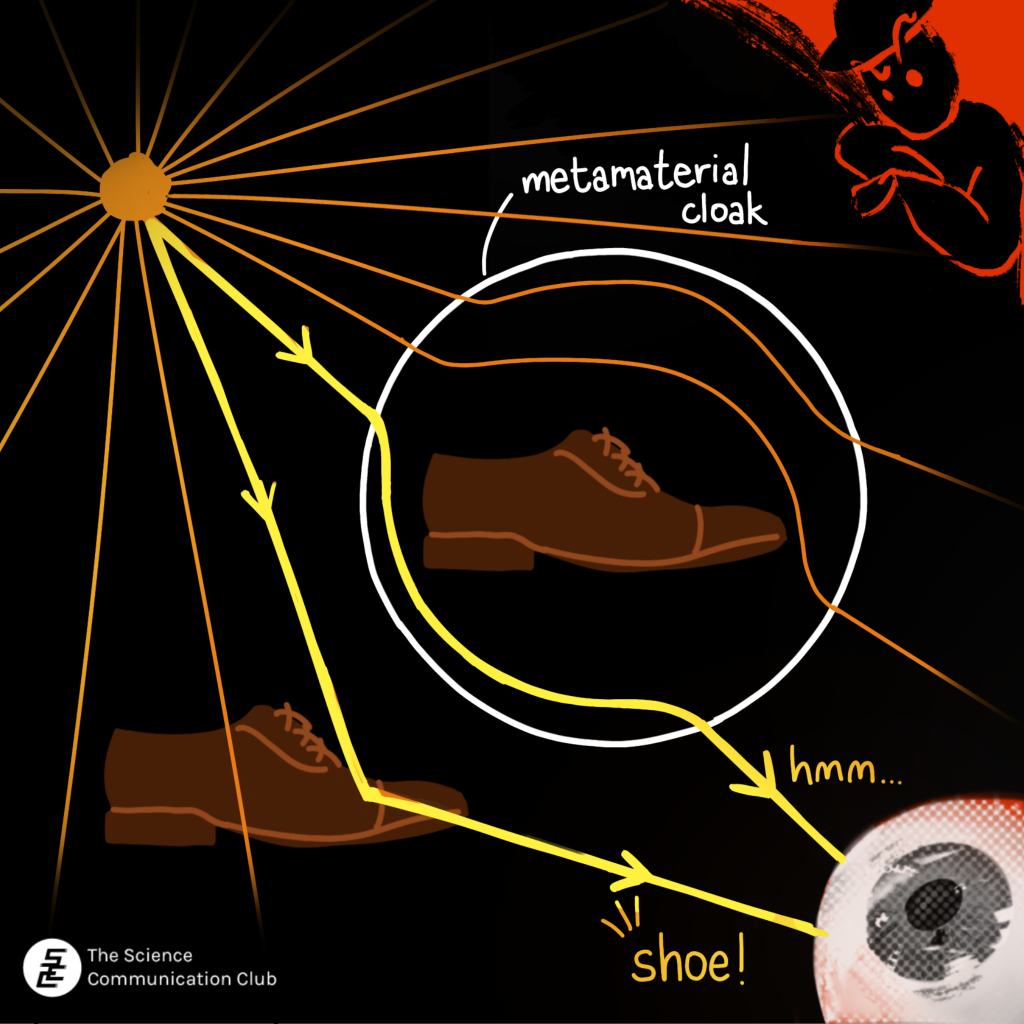
Written by Angie Lo
Illustrated by Yuki Lee
This article is part of our Special’s Week series, The Science of Science Fiction and Popular Media.
The power of invisibility has been wielded by countless fictional heroes—and many have wondered about bringing that power into the real world. Making the body turn invisible on its own sounds out of the question, but what about instances where characters disappear with the help of special invisibility-granting clothing or covers? Would it be possible to harness technology to invent something similar? Numerous scientists have been diving deep into optics—the study of light—to answer that question.
In order to understand what it means for something to not be seen, we’ll first have to start at what it means for something to be seen. When someone sees an object, it’s because light rays reflect off of it and enter their eyes—while light rays coming directly from behind the object are blocked, preventing someone from seeing anything behind it. If you want to make something invisible, you’ll need to be a lightbender—diverting light rays away from an object to prevent them from hitting it.
Your lightbending skills need to be super-precise as well: you’ll have to move the rays so that they go around an object, then, once they finish going around, you’ll have to re-orient the rays towards the same path they were originally taking. That way, the rays entering the eye will prevent the object from being seen, but won’t distort the sight of anything else1.
Amazingly, scientists have managed to perform this lightbending feat by creating metamaterials—artificial materials with the ability to control physical phenomena. These metamaterials could successfully push light rays away from themselves, causing the rays to take the exact path needed to ensure invisibility2. That way, objects enclosed by these materials could be completely obscured from sight—the first-ever invisibility cloaks!
Unfortunately, this invisibility isn’t very wide-ranging: scientists could only figure out how to make these metamaterials work for one specific wavelength of light, which corresponds to one light colour2,3. That means the material can grant invisibility in artificial environments where a single-coloured light is shone, but not out in the real world where multiple colours of light are present. So even though these invisibility covers are an awesome invention, they’re not exactly optimal for stealth.
Later on, in 2018, researchers from Canada’s Institut National de la Recherche Scientifique tried to overcome this obstacle by working with light a little differently—switching from lightbending to light-manipulation instead.

The researchers started with the fact that objects reflect light with the same wavelengths, or colours, as themselves—for instance, an orange always reflects orange light. This allows us to see objects for what they are. So the researchers came up with an ingenious device with the ability to shift light towards different wavelengths3. For example, if the device were to shield our orange, the device would hypothetically shift any orange wavelengths coming its way to wavelengths corresponding to another colour. Once the light travelled past the fruit, it would get shifted back to its original orange wavelength. This means that orange light could pass right through the fruit without ever being reflected—hiding the fruit from plain sight.
This method, termed “spectral cloaking”, allows for invisibility at all light wavelengths. Unfortunately, like the previous ones, this invisibility cloak isn’t perfect: as of now, it only allows for invisibility from one direction3. So though the researchers’ technique might allow you to stand unseen in the streets, as soon as you or someone else moves, it’s all over.
Complex inventions aren’t the only ways by which scientists have tried achieving invisibility. In 2014, researchers from the University of Rochester made an elegant invisibility device —dubbed the “Rochester Cloak”—using only four lenses. In fact, the device is so simple you can make it at home: the university has posted the instructions here. By positioning the lenses in a very specific way, you can accurately bend light so that when you’re in a certain region, you appear invisible when perceived through the lenses4. Of course, to stay unseen you’ll need your observers to keep their eyes fixed on the lenses—again, a pretty unlikely situation if you’re trying to be stealthy.
There’s also the issue of size. Larger objects are harder to work with, and current metamaterials aren’t able to conceal something as big as the human body2. Although researchers are hopeful that we can overcome this challenge with the help of new concepts and designs2, it’ll be a while before we may be able to get invisibility-granting clothes for people.
But though we’re still far from the possibility of turning invisible, scientists have still done some really cool things—figuring out how to control light in a super-precise way is an awesome feat in itself. And despite their limitations, our current devices still have potential practical applications: the Rochester Cloak, for instance, could one day allow surgeons to see through their hands, preventing their hands from blocking their view of what they’re operating on4. And for beings without the power of magic or ultra-futuristic technology, we’ve made some pretty significant steps towards the act of concealing things from sight. I’d say that our favourite invisibility-powered characters would definitely be impressed.
Sources
- Graham-Rowe D. Cloaking Breakthrough. MIT Technology Review. 2006 May 26 [accessed 2022 Nov 25]. https://www.technologyreview.com/2006/05/26/229046/cloaking-breakthrough/
- Monticone F, Alù A. Invisibility exposed: Physical bounds on passive cloaking. Optica. 2016;3(7):718–724. doi:10.1364/optica.3.000718
- Spectral Cloaking Could Make Objects Invisible Under Realistic Conditions. Optica: News Releases. 2018 Jun 28 [accessed 2022 Nov 25]. https://www.optica.org/en-us/about/newsroom/news_releases/2018/spectral_cloaking_could_make_objects_invisible_(1)/
- Invisibility cloaking device hides objects across range of angles. University of Rochester News Center. 2014 Sep 25 [accessed 2022 Nov 25]. https://www.rochester.edu/newscenter/watch-rochester-cloak-uses-ordinary-lenses-to-hide-objects-across-continuous-range-of-angles-70592/